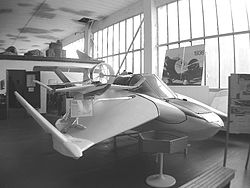Fischer Airfish AF-2
| FF Airfish AF-2 | |
|---|---|
 Airfish AF-2 in the Aviation Museum Merseburg |
|
| Type: | Ground effect vehicle |
| Design country: | |
| Manufacturer: | |
| First flight: |
1989 |
| Commissioning: |
1989 |
| Number of pieces: |
1 |
The Airfish AF-2 was a test vehicle from Fischer flight mechanics , which was geared towards the technical handling of ground - effect vehicles . The first test flights took place from 1989 in Essen on the Baldeney lake .
history
After Hanno Fischer and Klaus Matjasic had completed the technical documentation for their ground-effect vehicle with the Airfish AF-1 , Fischer revised the design in order to come closer to the practical requirements of boat operation with the vehicle. A serious disadvantage of the Airfish AF-1 was its large wingspan, which hindered operation in narrow waterways or at ship piers. This deficit was remedied with the new test vehicle called Airfish AF-2 .
construction
Fischer's new design largely retains the hull of the Airfish AF-1. It receives a new wing construction that has been shortened by 30% and a modified tail unit. Various hydromechanical changes and a new engine made it possible to significantly improve the wing loading compared to the AF-1 design. The Airfish AF-2 was created in 1989 with extensive reuse of assemblies from the first test vehicle AF-1.
testing
The testing of the Airfish AF-2 on Lake Baldeney near Essen was successful in 1989. The AF-2 was the first practicable airfish that could be used as a boat and that covered the needs of recreational boaters.
Technical specifications
| Parameter | FF Airfish AF-2 |
|---|---|
| crew | 1 |
| Passengers | - |
| length | 8.50 m |
| span | 6.80 m |
| height | 2.10 m |
| Wing area | m² |
| Wing extension | |
| Glide ratio | |
| Slightest sinking | |
| payload | |
| Empty mass | |
| Max. Takeoff mass | 580 kg |
| Cruising speed | 120 km / h |
| Top speed | |
| Service ceiling | 0.1 m |
| Range | |
| Engines | 70 hp (51 kW) |
Follow-up drafts
The American Bill Russel was interested in marketing the Airfish AF-2 in the American market in 1990 and specified his requirements for the first marketable ground-effect vehicle for pleasure boaters. Based on this specification, Hanno Fischer developed the Airfish AF-3 .
The test vehicle Airfish AF-2 later came to the Aviation Museum in Cologne and from there to its current location in the exhibition of the Aviation Museum Merseburg .
Related developments
- Airfish AF-1 (predecessor)
- Airfish AF-3 (further development)
See also
Web links
- AF-2 description at Fischer Flugmechanik (English)
Individual evidence
- ↑ Creapolis: Fischer Flugmechanik - A new technology in ground effect. 2011, accessed May 30, 2017 .
- ↑ WIG craft data sheets - Hoverwing WIG craft technology. Retrieved May 30, 2017 .